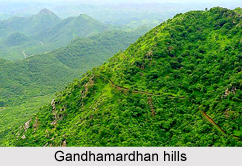 Gandhamardan Hills is a hilly area located in between Balangir District and Bargarh district of Odisha. Gandhamardan Hills is well known for medicinal plants. There is a Bauxite reserve which is planned for exploration by the State Government of Odisha with private venture.
Gandhamardan Hills is a hilly area located in between Balangir District and Bargarh district of Odisha. Gandhamardan Hills is well known for medicinal plants. There is a Bauxite reserve which is planned for exploration by the State Government of Odisha with private venture.
History of Gandhamardan Hills
Gandhamardan Hills also has a lot of historic importance as it was once a seat of Buddhist culture in ancient Odisha. Till date many ruins are found on the plateau at the hilltop. According to mythological history of Odisha, Lord Hanuman carried this hill on his shoulders from Himalayas to save the life of Lakshmana. In the Tretaya Yug (the Silver Age), Jambavan (the unerring counsellor of Lord Rama) had suggested Vir Hanuman to bring Bisalyakarani ere dawn, so that Laxman would rise back to life. It was in the middle of the war between Lord Rama and Ravana. Lord Hanuman failed to identify the particular herb and carried on his shoulders a huge Himalayan mass. While flying above and proceeding toward Lanka (the kingdom of Ravan), a portion dropped down. Gandhamardan is synonymous to that portion only. At northern slope of this hill the Nrusinghanath Temple is located; whereas on the southern slope of this hill is the famous Harishankar Temple located.
Gandhamardan Hills in Mahabharata Era
The sage Dronacharaya residing on this mountain belonging to the Mahabharata period used to deliver art of weaponry to the selected few pupils and he was famous for it across the country. The pupils educated and trained in the art of warfare were feared by many warriors of that time. Glowing tributes is paid to Hiuen Tsang, the champion Chinese traveller, who was attracted by the scenic splendour of Gandhamardan Hills. He has spoken of the flowering Buddhist University of Parimalgiri which had its campus on the picturesque Gandhamardan hills.
Medicinal Trees in Gandhamardan Hills
Gandhamardan Hills are a rich source of diversity for medicinal plants. The Botanical Survey of India has reported the existence of 220 plant species of medicinal value. The local people, however, claim that there are more than 500 species of medicinal plants in this area. The flora of the buffer zone is most vulnerable. Many medicinal plant species of Gandhamardan Hills such as Clerodendron indicum, Rauvolfia serpentina and Plumbago zeylanica, which were once available in plenty, have become scarce. A study recorded 2,700 angiosperms and 125 species of important medicinal plants, out of a total of 220 species of medicinal and quasi-medicinal and economically vital plants.
Use of Medicinal Plants
The medicinal plants are used in 100 traditional healthcare practitioners live in and around the Gandhamardan hills. These practitioners provide medical facilities to about 50,000 tribal people of India.
Related Articles
Odisha
Temples of Odisha
Districts of Odisha
Puri, Odisha
Forts in Odisha
Crafts of Odisha
Beaches of Odisha
Cities of Orissa



















